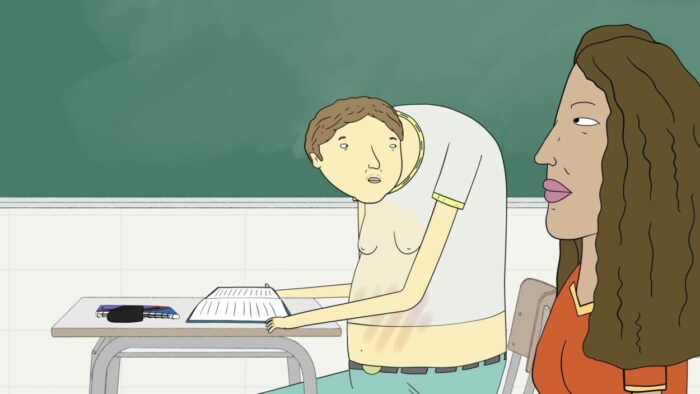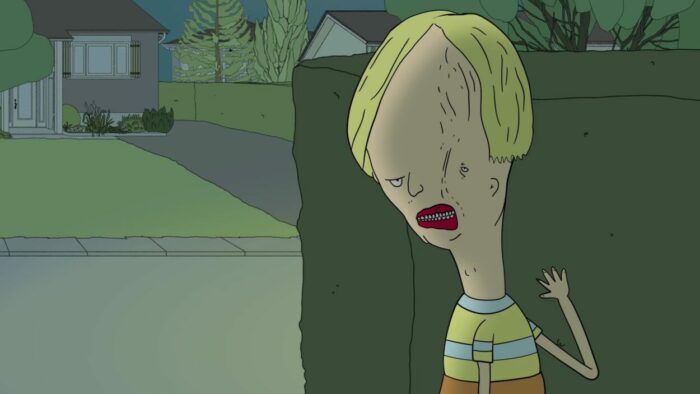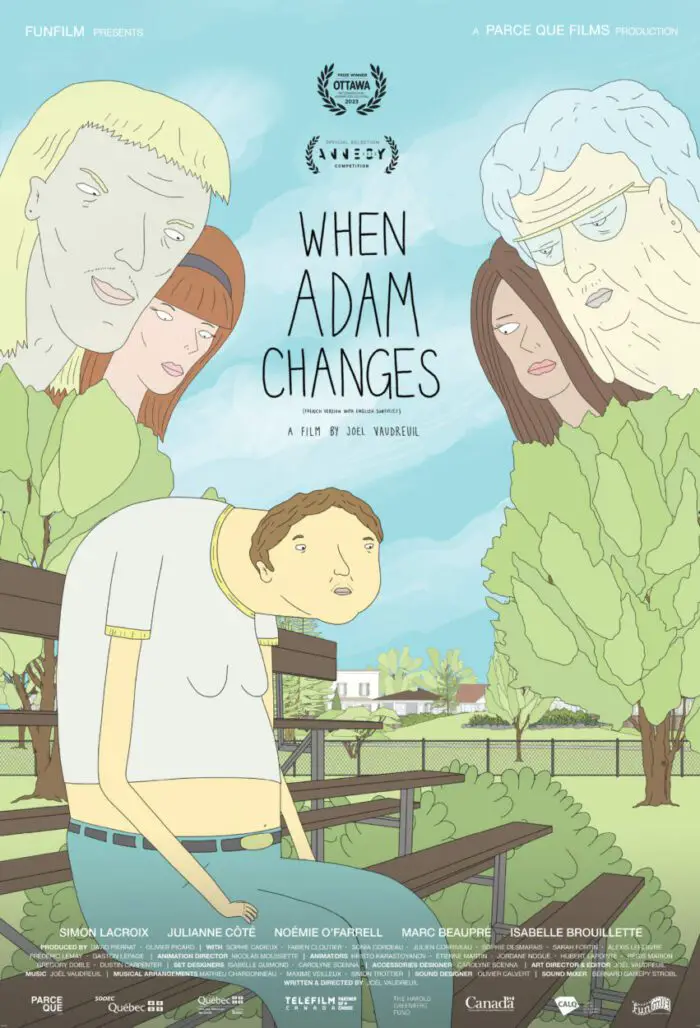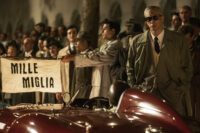Canadian writer and director Joël Vaudreuil has always dreamed of a teen coming-of-age film infused with genuine emotions, the kind too rarely seen among the fast-paced and unserious comedies that steer the genre’s conventions. His aim with his animated feature film When Adam Changes is to use deadpan humor and comic timing to depict his teenage protagonist Adam’s difficulties navigating the cruel and awkward indignities of adolescence.
At 15, Adam’s body is in the throes of change and subject to the mockery of those around him. It goes so far as to rebel, changing further in unpredictable ways at moments of intense adolescent emotion: shame, guilt, fear, anguish, humiliation. He suffers verbal and physical abuse from school bullies and family members both, and his attempts to make friends, especially with his popular, pretty classmate Jeanne, are met with more scorn than success. But over the course of a stultifying Quebec summer, the changes Adam is facing might just finally mark a turn for the better.
It’s a film filled to the brim with a gallery of unusual characters—a disfigured boy dragging a pipe, a poo-slinging English teacher, a mullet-coiffed metalhead, a prissy prep-school rich boy, and a quadriplegic cat—all headed towards a climactic moment that takes place “when Adam changes.” Hand-drawn and animated by a small team working from Vaudreuil’s sketches, the film uses its stark and sometimes strange renderings to depict a teenage summer marked by the stinging pangs of adolescence.
Vaudreuil has directed numerous music videos and the short films The Magnificent Life Underwater (2015), La récréation du midi (2010), six plain hot dogs (2011), and The River’s Lazy Flow (2013), which was presented in more than a hundred festivals around the world, including Annecy, Clermont-Ferrand and Tokyo. When Adam Changes is his first full-length feature film.
Vaudreuil recently spoke with Film Obsessive publisher J Paul Johnson about the inspirations and production of When Adam Changes. Below the video is a transcript of the conversation, edited for space and clarity.
Film Obsessive: Joël, your film is currently in a festival run, is that correct?
Joël Vaudreuil: Yes, it has done a lot of festivals. It premiered in France, and it is still running and will be released in Quebec around the summer, around May, maybe. It’s playing in Washington at the end of February and it will be played other places. I think it’s a good life for it. I’m really glad.
I’m sure it’s going to get a lot of very friendly reviews and applause and acclaim. Could you tell us a little bit about the story in your own words?
Yes. When I started to work on the movie, my first idea was to write a script about emotions more than about an action story. I wrote the script around feelings, emotions, the moment when you’re a teenager and you feel like a loss of control of what’s happening. And when you don’t have the emotional tools to face problems. The starting point of the movie was those emotions. Like something that makes you feel awkward but you don’t know how to really deal with it. I wanted to do a movie with deadpan dark humor. It’s based around feelings I used to feel when I was a teenager, but the things that I lived, just more the emotions, that are represented from my life.
It still, even aside from that, feels to me like it’s very grounded in a specific time and place, in ’90s around Quebec.
At that age, [Adam is] around 15 years old, the movie take place around like 1990, ’95. I didn’t do it because I was nostalgic for this time. I really like the fact that without the technology you used to feel more alone when you were alone because you weren’t connected, always with your friends and with people. I wanted to have a strange feeling when the phone rings and you don’t know who is it for this dread tension. You’re always wondering what people think because they don’t write it. I really like the music. The music of that time of the movie was written to be more true about what I used to feel at that age, that’s why it takes place in the ’90s.
It’s a pre- Internet film. It’s a pre-smartphone film. It’s a film where the characters literally do have to talk with each other in order to engage with each other. But they do that in some halting ways.
Yeah, that’s what I wanted to do. But it’s really funny to write a script about teenagers, as I said earlier, because I wanted the movie to talk about emotions and feelings. I think that’s the main reason why it took place in the ’90s because I really wanted to start from emotion. I used to feel the technology and the way you interact with friends influence the way you develop your feelings and your emotions and the way you react to those feelings and emotions.

And poor Adam, your protagonist. He’s at high school on the last day of the school year, heading into summer, and he has to withstand a great deal of harassment both from his family and his bullies at school. It feels like that comes from no apparent reason other than his body shape, personality as well. I’m wondering how you decided you were going to depict him visually.
Primarily, Adam is really the first sketch I did for the movie. I don’t work a lot on design when I write scripts. But sometimes I draw at the same time. Because when I don’t know what the character would say, I start to draw him. And when I see his face now, I can wonder what he would say. The design of the characters was done at the same time I was writing the story. I write the story and sometimes I block, and then I say, oh, okay, if he looks like that, he would say that or would react like that. It’s really close to the first sketch.
I didn’t study in art. My drawings are approximately the same that I used to draw in an agenda of my friends to make them laugh at the high school. It’s the way I draw, always my character. For me, it’s really natural for me to draw that kind of character. I don’t have techniques of drawing people with characters, with specific forms to help it animated. Because I didn’t study animation. My drawings are not necessarily drawings that you would do if you decide to create characters to be animated.
So you’re not the animator in the film, but your drawings provide the basis from which your key animator or animators work.
That’s correct, yes. It’s a blend of techniques. What I do is I draw all the characters in separate parts, in all the axes. Then we did the rig. It’s like if you do a numeric skeleton for the characters and around the skeleton, there’s my drawing. But the animator animates the skeletons. It’s all my drawings, but I’m not the guy who animated it. We developed this technique to be able to animate more than one scene at a time. We had a small team, but we were able to do like four or five scenes at a time.
I did a little bit of animation in the movie because the rigging animation is not the technique I use when I work alone. I did a lot of small animation: I animated the title, animated the stuff that was more rotoscopic, the explosion and stuff like that. I did a little part in animation, but my job was more in the design and in the drawing of the character. When the animation starts, I really become like the director of the animator, just like I would like direct actors.
I really love how it turned out. I’m just wondering how you would characterize the visual style of the film for somebody perhaps who hasn’t seen it yet.
It took a lot of influence elsewhere than in animation. I wanted to be more, the movie is really a phantasma of a movie I would have liked to seen in my life. That movie don’t really exist in the tone of movie with teenager protagonists, real fast edited and stroboscopic action and stuff like that. I wanted something really flat, maybe to express the summer when the teenagers are bored because they don’t get exciting vacations, they think it’s a little bit boring. I wanted that to be shown in the movie. Where you live, everybody seems to be like a little bit dead inside, without any magic.
I wanted the film to be really deadpan. My references were more about comic books for all the background. For the background artist, all the reference I used to give them was paper art more than animation. Because I didn’t want the camera movement that goes up and you see the sea. I wanted to stay really lo-fi—emotional, introspective. Everything is really flat and there’s not a lot of colors. It’s more like brown and yellow, but it’s not like fluorescent color and stuff like that. I really wanted to that all the movie feels the same way that the character feels like the small parts of magic in the movie a pulled down. When his body is morphing, it doesn’t grow like a building or something. It’s always like everything is really kept together: there’s a part of the magic, the character has to work to see the magic as a spectator. You have a part to fill the magic.

I love that. And I think that works perfectly well in the film. And I don’t know if it’s unique, but it certainly feels very much against the grain of most teen films. I’d also like to talk a little bit about story terms. I sense some kind of recognizable structures of a bit of a hero’s journey: Adam must leave home, cross a threshold, meet a princess, face an enemy, there’s a physical challenge at the end. Yet nothing about the film feels rote or predictable. But as a writer, are you conscious of narrative structures when you’re plotting the film? Are you looking to have your protagonists do those kinds of things or does it feel just more like a natural consequence of who this boy is?
I have a background as an editor. I’m really sensitive about the rhythm in the story. The movie for me is just about playing about the rhythm to a, like a constant. Something that keep interest for all the time. Because if the guy is just there and do nothing, it’s really boring. So you think something will happen. It’s really about the rhythm of the small characters. There’s a lot of small characters in the movie, like the people that are recurrent, but they are a constant presence in the protagonist’s life. It’s like a small danger, a small provocation, ordinary violence too. Like people say bad things but they aren’t even conscious that they say bad things. Because it’s just the way they talk and they never think it would affect somebody else.
For me, yeah, it’s really about the rhythm. I try to keep the pace all along throughout the storytelling.
You said you started with a feeling or an emotion you wanted to explore. Was it always your intent to do that with a hand drawn animated film following from your own drawings?
I do animation because of an accident. When I was younger I saw a movie and I realized that animation is just like the perfect storm of everything I like, because I like drawing, I like editing, I like writing, I like doing music, you know. If I do a comic book, I will always think about the music and about the sound and the voice. If I do a podcast, I will always think about the visual, how the people would look like if I just draw stuff. I think about music. Animation is really like an accident when everything collapses and it goes like in perfect place. Right now, when I write stories, it’s always the medium I’m thinking of in today.
It’s far from the most popular medium though, especially the hand drawn mode that you’re working in. Are festivals and distributors generally receptive to the notion of a hand drawn fictional feature in the marketplace today? Do you care? For instance, one of my recent interviewees, Philip Gelatt, made a film, The Spine of Night, a few years back, and it seemed very much like a labor of love, but at the same time it was a commercial challenge for him.
I think for me it’s going to be really romantic, I’m sorry. But I think [if you have a] passion, you don’t have to follow a movement. I cannot say I don’t like pop music. I cannot say I don’t like that kind of art. It’s just in each technique and medium, there’s someone that’s going to prove me wrong. That’s what I like about art is when you think you’re not going to like something and you see it and it proves you the thing for me, that’s perfect stuff.
In my heart, I don’t think I could change the way I work. I work that way because I feel it’s the way I should do it. You cannot do anything about the movie when it’s finished. You can just put the love in it when you’re doing it. But when it’s finished, I get a lot more money to do the movie. If I had a bigger team or if I had known people working on it. I think I think it wouldn’t change the fact that you do the best that you can while you’re doing it after. It’s not you to decide if it’s going to be something that people want to see or want to buy. I think it’s true about painting and music. I’m sure you can think of some things that you say, oh, I hate that kind of music, but in the back of your head, you know that there’s one band that you like.
Or I resist them for decades and then finally come to confess in my maturity that I really did secretly love them all along! When Adam Changes is such a lovely film and it feels so unlike so many others that I’ve seen. Is there any place specific coming up that our viewers and readers can look forward to seeing When Adam Changes?
The movie will be shown in Washington, I think it’s February 25. It showed at the Animation First. Festival in New York, and they show some of the movies in Washington at the end of February. I know if there’s another festival that is showing it, but for now it’s the United States. The premiere in the States was two weeks ago. It’s really new.
For now it is. And I’ll be sure to provide a link to the Washington screening for our viewers. I want to offer you my congratulations on the completion of a lovely film, and I want to thank you also for interjecting some new life into a too often overlooked and under practiced art form. I think all of us who appreciate hand drawn animation wish we would get to see more of it, really, than we do.
Thank you a lot and thanks for speaking about it.




